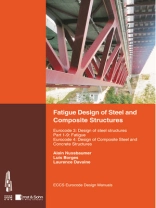This volume addresses the specific subject of fatigue, a subject not familiar to many engineers, but still relevant for proper and good design of numerous steel structures. It explains all issues related to the subject: Basis of fatigue design, reliability and various verification formats, determination of stresses and stress ranges, fatigue strength, application range and limitations. It contains detailed examples of applications of the concepts, computation methods and verifications.
Table of Content
PREFACEACKNOWLEDGMENTS
SYMBOLOGY
TERMINOLOGY
1 INTRODUCTION
1.1 Basis of fatigue design in steel structures
1.2 Damage equivalent factor concept
1.3 Codes of Practice
1.4 Description of the structures used in the worked examples
2 APPLICATION RANGE AND LIMITATIONS
2.1 Introduction
2.2 Materials
2.3 Corrosion
2.4 Temperature
2.5 Loading rate
2.6 Limiting stress ranges
3 DETERMINATION OF STRESSES AND STRESS RANGES
3.1 Fatigue loads
3.2 Damage equivalent factors
3.3 Calculation of stresses
3.4 Modified nominal stresses and concentration factors
3.5 Geometric stresses (hot spot stresses)
3.6 Stresses in orthotropic decks
3.7 Calculation of stress ranges
3.8 Modified Nominal stress ranges
3.9 Geometric stress ranges
4 FATIGUE STRENGTH
4.1 Introduction
4.2 Fatigue detail tables
4.3 Determination of fatigue strength or life by testing
5 RELIABILITY AND VERIFICATION
5.1 Generalities
5.2 Strategies
5.3 Partial factors
5.4 Verification
6 BRITTLE FRACTURE
6.1 Introduction
6.2 Steel quality
6.3 Relationship between different fracture toughness test results
6.4 Fracture concept in EN 1993-1-10
6.5 Standardisation of choice of material: maximum allowable thicknesses
REFERENCES
ANNEX A STANDARDS FOR STEEL CONSTRUCTION
ANNEX B FATIGUE DETAIL TABLES WITH COMMENTARY
ANNEX C MAXIMUM PERMISSIBLE THICKNESSES TABLES
About the author
Alain Nussbaumer ist Professor für Stahlbau an der Eidgenössischen Technischen Hochschule Lausanne (EPFL). Er ist Mitglied des CEN TC 250-SC3 und Vorsitzender des schweizerischen Komitees SIA 263 Stahlkonstruktionen. Er ist außerdem Mitglied und ehemaliger Vorsitzender des technischen Komitees TC6 ‘Ermüdung’ der EKS.Luís Borges ist leitender Ingenieur bei BG Ingenieure und Berater in der Schweiz. Er promovierte an der Eidgenössischen Technischen Hochschule Lausanne (EPFL) über Ermüdung von Brückenkonstruktionen und ist Spezialist für Stahl- und Verbundbrücken. Er ist Mitglied des technischen Komitees TC6 ‘Ermüdung’ der EKS.
Laurence Davaine ist leitende Ingenieurin in der Brückenabteilung der staatlichen Eisenbahngesellschaft Frankreichs (SNCF) und ist Spezialistin für Stahl- und Verbundbrücken. Sie promovierte an der École Nationale des Ponts et Chaussées (ENPC) über Stabilität von Blechträgern für Brücken. Sie ist Mitglied des technischen Komitees TC6 ‘Ermüdung’ der EKS.
Language English ● Format PDF ● Pages 311 ● ISBN 9783433601211 ● File size 11.0 MB ● Publisher Ernst, Wilhelm & Sohn ● Published 2012 ● Edition 1 ● Downloadable 24 months ● Currency EUR ● ID 2440143 ● Copy protection Adobe DRM
Requires a DRM capable ebook reader












